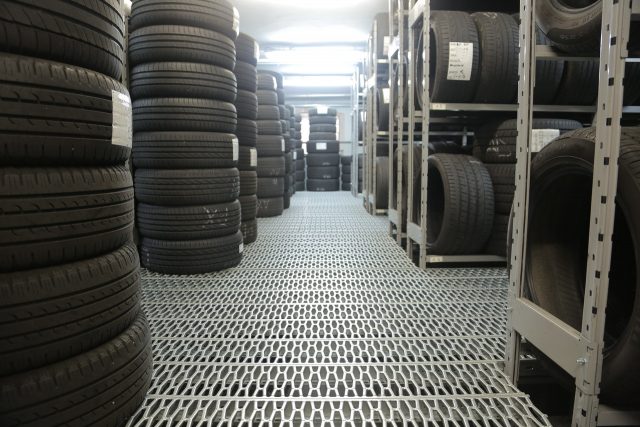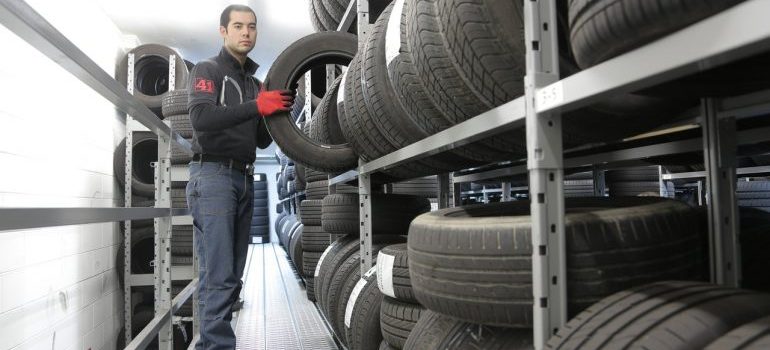Tips for storing tires long-term
get a quote
Storing tires correctly in your chosen self storage in Seattle keeps them in great shape for when you need them again, whether for seasonal use or extended periods. Poor storage can lead to premature wear, cracking, and flat spots that can render them unsafe for driving. To prevent damage and maximize tire life, follow these straightforward tips for storing tires long-term!
Clean your tires thoroughly
Before storing, wash your tires thoroughly to remove any dirt, brake dust, and road grime. Chemicals, oil, and dirt left on the tires can slowly break down the rubber, weakening them over time. Use a mild soap solution and a tire brush to scrub each tire. Avoid using harsh chemicals or cleaners that contain petroleum, as they can harm the rubber. Dry each tire completely before moving on to storage. Moisture left on the tires can lead to mold and can even degrade the rubber.
Choose the right storage environment
Tires are sensitive to extreme temperatures, sunlight, and moisture. Hence, when selecting a spot to store your tires, ensure the environment meets the ideal conditions for long-term storage. Use this checklist to keep your tires protected from damage over time:
- Cool and dry location: find a portable on-demand storage Seattle solution away from extreme temperature changes.
- Out of direct sunlight: select a dark area or use tire covers to block UV exposure.
- Climate-controlled (if possible): climate control can help protect tires from both temperature and humidity changes.
- Away from heat sources: ensure the storage spot is distant from furnaces, heaters, or water heaters.
- Protected from chemicals: keep tires away from equipment that emits ozone (e.g., electric motors, generators).
- Off cold concrete: use plywood or cardboard under the tires if they must be placed on concrete.
This checklist helps you maintain a stable environment, extending the lifespan and performance of your tires.

Keep tires away from chemicals and heat sources
Tires should not be stored near heat sources like furnaces, heaters, or water heaters. Heat can speed up the tire’s aging process, causing the rubber to harden or crack. Additionally, avoid storing tires near equipment that emits ozone, such as electric motors and generators. Ozone exposure can lead to sidewall cracking, which compromises tire strength and safety.
Consider storing tires vertically
If your tires are still on their rims, it’s best to store them stacked or hung on racks to prevent flat spots from developing on one part of the tire. For tires without rims, store them upright. Vertical storage reduces the likelihood of deformities in the tire shape. If space in your storage pods in Seattle allows, use tire racks or similar supports to keep them off the ground and allow for easy access when you need them.
Use tire covers or bags
Using tire covers or bags can help maintain the quality of your tires during storage. These covers keep tires protected from dust and moisture, which can slowly degrade the rubber. For added protection, place each tire in a plastic bag after cleaning and drying them. Make sure there’s as little air as possible inside the bag before sealing it, which reduces the chances of oxidation and prevents moisture buildup.
Avoid placing tires on a cold concrete floor
Cold concrete can draw moisture from the ground, which can damage tires over time. Place a protective barrier, such as a piece of plywood or cardboard, between the tires and the concrete floor. This simple step keeps tires from directly touching a cold or potentially damp surface.

Rotate periodically when storing tires long-term
If you’re storing tires for an extended period, rotate them every few months to maintain even pressure on all sides. This tip is especially important for tires stored horizontally or stacked. Periodic rotation reduces the chance of developing flat spots or warping, ensuring your tires are ready for use when you need them.
Check tire pressure if stored on rims
For tires stored on rims, check the tire pressure periodically. Tires stored long-term can lose air over time, leading to flat spots. Inflate the tires to the recommended pressure before storing them in your Renton self storage, and check them once every few months. Keeping them properly inflated reduces the risk of flat spots and ensures that they’re ready to go when you reinstall them.
Store tires with or without rims separately
While both tires with and without rims can be stored long-term, they require different handling. Tires stored on rims should be stacked or hung, while those without rims should stand vertically. It helps reduce stress on the tire walls and prevents deformation. When storing tires with rims, make sure they’re protected from moisture, as moisture can cause rust on the metal rims. Applying a thin layer of anti-corrosion spray on the rims can prevent rust.
Avoid using harsh products on tires
When preparing tires for long-term storage, avoid using any harsh cleaning products or tire shine sprays that contain petroleum or other chemicals harmful to rubber. Some cleaners might make tires look shiny, but they can damage the rubber in the long run. Stick to a mild soap and water solution, and dry the tires thoroughly before storing them.

Label and keep track of stored tires
If you’re storing multiple sets of tires, label each one according to its position on the vehicle (e.g., front left, rear right). This way, you’ll know exactly where each tire was when you last used it, which can be helpful for even wear when you reinstall them. Labeling also makes it easy to organize your tires, so you’re not left guessing when it’s time to put them back on the vehicle.
Inspect tires before reuse
Inspect your tires carefully when it’s time to bring them out of storage. Look for signs of cracking, flat spots, or any uneven wear that could indicate issues. If the tires have developed cracks or if the rubber feels excessively hard, they may no longer be safe to use. Check the tire tread depth and condition as well. Tires with tread depth below the recommended level should be replaced, as they may no longer provide safe traction on the road.
Risks and rewards of long-term tire storage
Storing tires long-term comes with both risks and rewards. Improper storage can lead to cracking, flat spots, and weakened rubber, which compromise safety and durability. However, by following a few simple steps—cleaning, choosing the right environment, and using protective covers—you protect your tires from these risks. With proper storage, you extend tire life, save on replacement costs, and ensure your tires are always safe and ready. Taking the time to store them correctly is a small effort with significant benefits.
